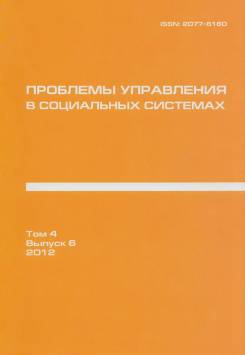Features of a club-type structures and their role in socio-economic life of the country in an era of socialism
The development of modern consumer society, the increasing role in the lives ofpeople initiated the rapid development of club communities whose importance in public life and the economy is growing steadily. Although the theory of clubs originated in the West, the Soviet Union also had formal and informal club coordination mechanisms for collective action as individuals and businesses. The article analyses the processes of exchange, creation and distribution of wealth in a planned economy and reduced functionality of money, specificity of Soviet collective club-type communities, their role in socio-economic life of the country, forming its institutional environment.
Keywords
information exchange,
trade in conditions of socialism,
coordination,
institutions,
networks,
formal and informal clubs,
theory of clubs,
информационный обмен,
координация,
товарообмен в условиях социализма,
институты,
сети,
формальные и неформальные клубы,
теория клубовAuthors
| Pleschenko Vjatcheslav I. | Head of Dept. Goznak (Moscow) | v_pl@mail.ru |
Всего: 1
References
Добренко Е. Политэкономия соцреализма. - М.: Новое литературное обозрение, 2007. - 592 с.
Николаева У. Архаизация отношений препятствует развитию [Электронный ресурс]. - Режим доступа: URL: http://www.opec.ru/1682424.html (дата обращения 20.05.2014).
Гудко Л., Дубин Б. «Нужные знакомства»: особенности социальной организации в условиях институциональных дефицитов // Мониторинг общественного мнения: экономические и социальные перемены. - 2002. -№ 3 (59). - С. 24-39.
Кордонский С.Г. Рынки власти. Административные рынки в СССР и России. - М.: ОГИ, 2006. - 240 с.
Петрако Н.Я. Русская рулетка: экономический эксперимент ценою 150 миллионов жизней / ред. кол. Д.С. Львов (пред.) и др. - М.: ОАО «Издательство «Экономика», 1998. - 286 с.
Дубин Б. Институты, сети, ритуалы // Pro et Contra. - 2008. - Т. 12, № 2-3. - С. 24-35.
Ольсевич Ю.А., Худокормов А.Г. Наследие варварства и цивилизованные институты / Мировая экономическая мысль. Сквозь призму веков: В 5 т. / сопред. редкол. Г.Г. Фетисов, А.Г. Худокормов. Т. III. Эпоха социальных переломов; отв. ред. Ю.Я. Ольсевич. - М.: Мысль, 2005. -С. 322-337.
Долгин А.Б. Манифест новой экономики. Вторая невидимая рука рынка. - М.: АСТ, 2010. - 256 с.
Клейнер Г. Микроэкономика знаний и мифы теории // Высшее образование в России. - 2006. - № 9. - С. 32-37.
Сакоян А. Клубы на благо общества [Электронный ресурс]. - Режим доступа: URL: http://polit.ru/article/2012/11/01/clubs/ (дата обращения 15.05.2014).
Долгин А.Б. Как нам стать договоропригодными, или Практическое руководство по коллективным действиям. - М.: ОГИ, 2013. - 192 с.

